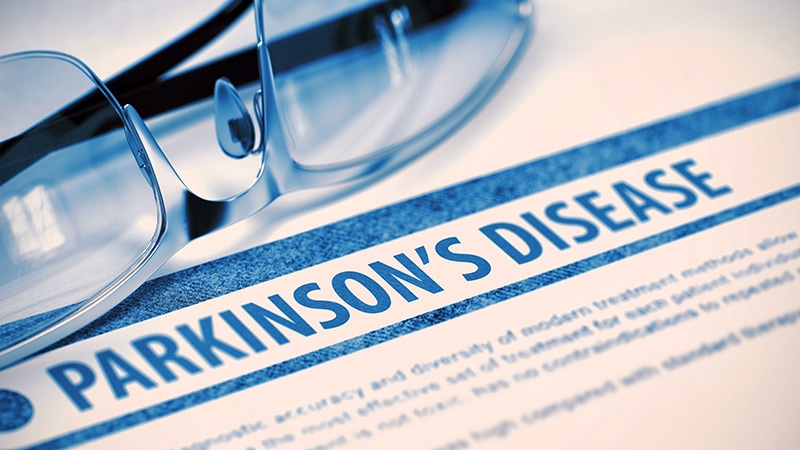A novel experimental drug for early Parkinson’s disease (PD) yielded similar results as commercially available pramipexole extended-release (ER) but with significantly less daytime sleepiness, a new study shows.
The findings are the latest from a phase 3 trial of P2B001, an experimental drug that combines low-dose, ER formulations of pramipexole and rasagiline. Both drugs are already available at higher dosages. Extended-release rasagiline is not commercially available.
P2B001 manufacturer Pharma Two B plans to submit a new drug application to the US Food and Drug Administration this year. If approved, it would offer a new first-line option for early PD that would be taken once daily without titration.
“One of the biggest questions for clinicians who treat Parkinson’s patients is what do I start newly diagnosed patients on and when do I start them,” said trial investigator Lawrence W. Elmer, MD, PhD, Department of Neurology, University of Toledo College of Medicine and Life Sciences, who presented the findings here at the American Academy of Neurology 2023 Annual Meeting.
“This inability of clinicians to know what to start patients on actually leads to an increase in the cost of caring for these patients because they are inadequately managed,” Elmer told Medscape Medical News.
“That’s why I thought this concept was so innovative because the goal was to design a compound that literally could be given to every single newly diagnosed patient with Parkinson’s disease that will work in the vast majority of those patients with the best tolerability I’ve seen in a compound in almost 20 years,” he added.
Promising Results
Levodopa is widely considered to be the most effective treatment for PD, but long-term use is associated with increased risk for motor complications, such as dyskinesia.
Previous studies have found that dopamine agonists such as pramipexole have been linked to excessive daytime sleepiness and impulse control disorders. Monoamine oxidase B inhibitors such as rasagiline are not as effective at controlling PD as are other treatment options.
P2B001 combines 0.6-mg pramipexole and 0.75-mg rasagiline, both as ER. Pramipexole ER is currently available in doses of 1.5-4.5 mg. Rasagiline ER is not available, but monotherapy rasagiline is approved at 1 mg daily.
The international, multicenter, randomized, double-blind, parallel-group trial of P2B001 included study included untreated PD patients who received one of four treatments:
Participants received P2B001, a once-daily ER combination product composed of pramipexole 0.6 mg and rasagiline 0.75 mg; pramipexole ER capsule 0.6 mg once daily; rasagiline ER capsule 0.75 mg once daily; or the currently marketed product pramipexole ER capsules titrated to an optimal dose for each individual patient (1.5-4.5 mg).
As reported by Medscape Medical News, results from the first three randomized groups demonstrated that P2B001 was more effective than were its individual components.
This latest study included 147 patients who received P2B001 and 72 treated with pramipexole ER.
After 12 weeks of therapy, 74.3% of patients receiving P2B001 and 75.8% of those receiving a mean dose of 3.2-mg pramipexole ER showed an at least four-point improvement in Unified Parkinson’s Disease Rating Scale, with no significant difference between groups.
However, patients in the trial group had significantly fewer dopaminergic adverse events compared with those on pramipexole ER (44.7% vs 66.2%, respectively; P = .002). This included lower rates of sleepiness (14.7% vs 31.1%) and orthostatic hypotension (2.7% vs 12.2%).
Questions Remain
Commenting on the study, Rebecca Gilbert, MD, PhD, chief scientific officer for the American Parkinson Disease Association told Medscape Medical News that “daytime sleepiness and orthostatic hypotension can be significant side effects with dopaminergic agents and a method of delivering dopamine agonists with the same symptomatic benefit and without these side effects would definitely be beneficial.”
However, there are a number of unanswered questions about P2B001, added Gilbert, who was not part of this study.
For example, is the experimental drug more effective than is the currently available treatment of pramipexole ER 1.5 mg taken once daily with rasagiline 1 mg, a combination that doctors can give to patients now “without the price tag of a newly approved medication,” Gilbert said.
“The bottom line is that this compound is a combination of two available medications,” she added, with the exception that the rasagiline portion is an extended-release formulation that is not available commercially at the moment.
Though P2B001 might offer some benefits, the combination medication “is not the innovation that the PD community is hoping for,” Gilbert said. “I also anticipate that if such a medication is approved in the US, insurance companies will make it very difficult to use as they will require use of pramipexole ER and rasagiline before considering paying for a combination medication.”
The study was funded by Pharma Two B. Elmer serves on a speakers bureau for a number of pharmaceutical companies, including Acadia Pharmaceuticals, Acorda Therapeutics, Amneal Pharmaceuticals, and Teva Pharmaceuticals. Gilbert reports no relevant financial conflicts.
American Academy of Neurology 2023 Annual Meeting. Presented April 25, 2023. Abstract #3733
For more Medscape Neurology news, join us on Facebook and Twitter
Follow Medscape on Facebook, Twitter, Instagram, and YouTube
Source: Read Full Article






